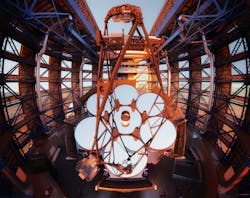November 4 is a big day for anyone in the field of astronomy or astrophysics. It's the day when the National Academy of Sciences releases its Astronomy and Astrophysics Decadal Survey (Astro2020), providing scientists with a strategic vision for the decade ahead. The results generate consensus recommendations often prioritizing research activities including those associated with the growing number of next generation telescopes scheduled to reach operational status over the next decade.
And, there is more to a telescope than meets the eye. This is especially true when considering the world's largest telescope currently under construction, known as the Giant Magellan Telescope (GMT).
According to James Fanson, project manager of the Giant Magellan Telescope, the most important part of a telescope is its light-collecting mirror, and the GMT includes seven of the world's largest mirrors, each measuring in at 28 feet in diameter. “The larger the mirror, the deeper we can see into the universe and the more detail we can observe," he says. "The discoveries these mirrors will make will transform our understanding of the universe.”
To put the size and power of the GMT into perspective, once fully operational, the mirror-array will sport a light collecting area of 368 square meters, enabling scientists to see the torch engraved on a dime from nearly 100 miles away -- that is roughly ten times sharper than the often heralded Hubble Space Telescope.
From the beginning
The process of creating the giant mirrors is taking place at Arizona’s Richard F. Caris Mirror Lab. The multi-step four year process involves melting nearly 20 tons (38,490 pounds) of high-purity, low-expansion, borosilicate glass (E6) into the world’s only spinning furnace designed to cast giant mirrors for telescopes. At the peak of the melting process, the furnace spins at five revolutions per minute, heating the glass to 1,165 degrees Celsius (2,129 F) for approximately five hours until it liquefies into the mold. The mirror then enters a one month annealing process where the glass is cooled while the furnace spins at a slower rate in order to remove internal stresses and toughen the glass. It takes another six weeks to cool the glass to room temperature. This “spin cast” process gives the mirror surface its special parabolic shape. Once cooled, the mirror will be polished for two years before reaching an optical surface precision of less than one thousandth of the width of a human hair or five times smaller than a single coronavirus particle.
The E6 glass used to create the GMT mirrors comes from Ohara. Creating the E6 glass starts with the mostly manual process of forming an 800 liter clay pot. Once shaped, the clay pot must be air dried and then baked. It takes about 4 months to complete the entire process. This clay pot melting method is similar to those used in the earliest days of optical glass production.
Each lot of Ohara E6 glass requires 1.5 tons of various raw materials in powder form, evenly mixed using a V-shaped blender. During the melting process, the temperature reaches as high as 1500 degrees C and the powders are transformed within the clay pot from a solid to a liquid state. To reduce striae and bubbles, the melted glass is periodically stirred. The melting process takes about 53 hours to complete.
The E6 chunks are visually inspected for bubbles, inclusions and striae. The chunks are also inspected for stress birefringence using a cross polarization method. Areas of the glass found to contain high stress are scribed and removed. Ohara then takes E6 samples from each lot and measures the Coefficient of Thermal Expansion (CTE). Once the E6 glass has passed all of the quality control and inspection criteria, it is ready for packaging and shipment to the mirror lab.
Entering the mirror lab
When the mirror lab ultimately melts the blocks, they fuse together without any trace of individual blocks, explains Buddy Martin, project scientist for the mirror polishing at University of Arizona's Mirror Lab.
The GMT uses lightweight honeycomb mirrors, which gives them the best mechanical and thermal properties to work in a telescope, while keeping their shape to an accuracy of a few millionths of an inch, forming the best possible images nature allows.
Martin’s team uses a mold that is the negative of the honeycomb – essentially a big tub filled with roughly 1700 hexagonal boxes to form the honeycomb. The honeycomb design is crucial in making a lightweight mirror. In fact, the final mirror only has 20% of the mass of a solid mirror with the same exterior dimensions. The goal is to create a product capable of overcoming the negative impacts of it own weight causing it to sag as the telescope points in different directions and bending due to wind as the mirror is exposed to the elements.
The heating process occurs over 4-5 days, explains Martin. “Once the glass reaches peak temperature, it has the consistency of molasses, and it flows slowly down the half inch thick gaps between the hexagonal boxes, creating the honeycomb ribs,” he says. “The boxes are on standoffs to raise them about an inch above the floor and the glass will flow underneath the boxes to form the backplate of the mirror. Because the glass is relatively viscous, it takes about three or four hours for it to flow down and completely fill the honeycomb volume.”
The ceiling of the furnace is equipped with cameras to provide crude images of the glass. “Because we can see when the glass completely fills the mold, we can start cooling it to around 650 degrees C, at which point it is macroscopically solid and will not change its shape. We will stop the rotation, but the glass is still soft on the atomic scale. The atoms can still slide relative to each other, due to variations in density and pressure, we'll finally get locked in place at about 500 degrees C. So, it's essential to make the density as uniform as practicable at that point. The process takes about 3 months.”
Finishing processes
While casting provides the desired mechanical structure, it doesn't yield an optical surface. The first step in achieving the desired surface is to grind and polish the back of the mirror because it serves as the interface to the telescope. "We need to have accurate flat surface, and we'll permanently bond 165 metal interface pieces between the mirror and the telescope to serve as the support system. The mirror is upside down throughout this process," says Martin.
At this point, the team turns the mirror right side up, which changes the stresses in the glass, but it remains right side up for the rest of its life. The team completes a similar grinding process on the front surface with significant attention focused on achieving higher levels of accuracy. "We have to eventually make the optical surface is accurate to a little better than 1,000,000th of an inch for the typical deviation from the perfect surface," he says.
The mirror goes through several stages of grinding, starting with course abrasives and getting to finer abrasives and there are also two major steps in that grinding process. Initially, it's a machining operation with the mirror on a big mill using a spindle with a diamond tool spinning at 1000 rpm. The tool moves slowly across the surface as the mirror rotates on a turntable. It covers the whole surface, carving out whatever glass is in its way.
The next step, lapping, yields an accuracy of about two microns. This is followed up with 70-80 iterations of a complex polishing process to improve accuracy from two-micron to 20 nanometer takes time and a lot of repetition between polishing and measuring.
Addressing unanswered questions
The development of next generation telescopes like the GMT will play an important role in answering some of the astronomy's biggest mysteries including better understanding universe formation, exoplanets and blackholes, according to Rebecca Bernstein, GMT’s chief scientist. “Everybody likes to talk about adaptive optics and reaching the diffraction limit of the primary mirror,” she says. “On GMT, we do that with just the two mirror surfaces, so by the time you form an image, you have already reached the diffraction limit of the telescope. You do not need more mirror surfaces or another instrument downstream.”
The GMT will be able to study the very first stars that ever formed in the universe, study the process by which those first stars began to form, and then how they've evolved since.
About the Author
Peter Fretty
Market Leader, Digital Infrastructure
Peter Fretty began his role as the Market Leader, Digital Infrastructure in September 2024. He also serves as Group Editorial Director for Laser Focus World and Vision Systems Design, and previously served as Editor in Chief of Laser Focus World from October 2021 to June 2023. Prior to that, he was Technology Editor for IndustryWeek for two years.
As a highly experienced journalist, he has regularly covered advances in manufacturing, information technology, and software. He has written thousands of feature articles, cover stories, and white papers for an assortment of trade journals, business publications, and consumer magazines.

